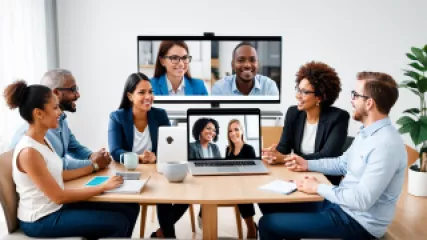Mastering Conflict Resolution: An Interview with a Leading Online Therapy Expert
Mastering Conflict Resolution: An Interview with a Leading Online Therapy Expert
Conflict is an inevitable part of life, but how we navigate and resolve it can make all the difference. In this insightful interview, we sit down with Jade King, a renowned expert in the field of online conflict resolution therapy, to uncover the secrets to effectively managing disputes and fostering healthier relationships.
The Importance of Conflict Resolution in the Digital Age
In today's fast-paced, technology-driven world, the way we communicate and interact with one another has undergone a significant transformation. With more and more of our personal and professional lives taking place online, the need for effective conflict resolution strategies has never been greater.
"Conflict doesn't just disappear because we're communicating through a screen," explains Jade. "In fact, the lack of face-to-face interaction and the prevalence of misunderstandings can often exacerbate conflicts, making them more challenging to resolve. That's why it's crucial for individuals and organizations to prioritize conflict management skills and seek out support when needed."
Jade's expertise in online therapy has given her a unique perspective on the complexities of conflict resolution in the digital age. She has witnessed firsthand how the virtual landscape can heighten emotions, erode empathy, and make it harder for people to find common ground.
Navigating Conflict in the Digital Realm
One of the primary challenges of resolving conflicts online is the lack of nonverbal cues. "When we're face-to-face, we can pick up on subtle body language, tone of voice, and facial expressions that help us gauge the other person's emotional state and adjust our approach accordingly," Jade explains. "But in a virtual setting, those important nuances can be lost, leading to misunderstandings and escalating tensions."
To overcome this hurdle, Jade emphasizes the importance of clear, concise, and empathetic communication. "It's crucial to choose your words carefully, avoid inflammatory language, and make a conscious effort to understand the other person's perspective. Active listening, validating feelings, and seeking common ground are all essential skills for effective online conflict resolution."
Another challenge that Jade has observed is the tendency for people to be more emboldened or confrontational when they're behind a screen. "The anonymity and distance of the digital world can sometimes make people feel more comfortable expressing their anger or frustration in ways they might not if they were in the same room. This can lead to escalation, defensiveness, and a breakdown in communication."
To combat this, Jade emphasizes the importance of maintaining a calm, measured approach. "It's crucial to stay level-headed, avoid reactive behaviors, and focus on finding constructive solutions. Sometimes, that may mean taking a break from the conversation and revisiting it when emotions have settled."
The Benefits of Online Conflict Resolution Therapy
In Jade's experience, online therapy can be a powerful tool for helping individuals and teams navigate conflicts more effectively. "Virtual sessions offer a safe, confidential space for people to explore their feelings, unpack the root causes of the conflict, and develop personalized strategies for resolution. The convenience and flexibility of online therapy can also make it more accessible for those who may have difficulty attending in-person sessions."
Jade has seen firsthand how online conflict resolution therapy can help clients improve their communication skills, enhance empathy, and build stronger, more resilient relationships. "By providing a structured, facilitated environment, we're able to help clients navigate conflicts in a productive, constructive way. They learn to listen actively, express themselves clearly, and find common ground – skills that are invaluable both in the virtual and the physical world."
Conflict Resolution Strategies for the Online World
When it comes to effective conflict resolution in the digital realm, Jade emphasizes the importance of a multi-faceted approach. "There's no one-size-fits-all solution, as each conflict and each individual is unique. However, there are some key strategies that can help people navigate online disputes more effectively."
1. Establish Clear Communication Protocols
Jade advises clients to set clear guidelines for how they will communicate during a conflict, such as agreeing on response times, tone, and the use of video or audio. "Having these protocols in place can help minimize misunderstandings and ensure that everyone is on the same page."
2. Practice Active Listening
In the virtual world, where nonverbal cues are limited, active listening becomes even more crucial. "Make a conscious effort to truly hear and understand the other person's perspective, rather than just waiting for your turn to speak. Summarize what you've heard, ask clarifying questions, and validate their feelings."
3. Manage Emotions Proactively
Jade emphasizes the importance of emotional self-awareness and regulation, especially in the heat of a conflict. "If you feel yourself getting overwhelmed or reactive, take a break, breathe deeply, and reflect on how you can respond in a more constructive way. Avoid impulsive or escalating behaviors that can further exacerbate the situation."
4. Focus on Problem-Solving
Rather than getting bogged down in blame or accusations, Jade encourages her clients to shift their mindset towards collaborative problem-solving. "Approach the conflict as a challenge to be overcome together, rather than a battle to be won. Brainstorm creative solutions, identify common goals, and work towards a mutually beneficial outcome."
5. Seek Professional Support
For individuals or teams struggling to resolve persistent conflicts, Jade recommends seeking the guidance of a professional conflict resolution therapist. "An experienced online therapist can provide a neutral, objective perspective, as well as proven techniques for navigating even the most complex disputes. Don't hesitate to reach out for help – it can make all the difference."
The Future of Conflict Resolution in the Digital Age
As technology continues to shape the way we live, work, and interact, Jade believes that the field of online conflict resolution therapy will only grow in importance. "The ability to effectively manage conflicts in the virtual realm is no longer a nice-to-have; it's a essential skill for navigating the modern world. And as more people recognize the value of professional support, I expect to see a surge in demand for these services."
Jade is optimistic about the potential for technology to enhance conflict resolution, particularly as advancements are made in areas like virtual reality and artificial intelligence. "Imagine being able to role-play conflict scenarios in a VR environment, or having an AI assistant that can analyze communication patterns and provide real-time coaching. The possibilities are truly exciting, and I'm eager to see how the field evolves to meet the needs of our increasingly digital society."
For those who may be hesitant to seek help, Jade emphasizes the importance of overcoming the stigma and embracing the power of professional support. "Conflict resolution isn't a sign of weakness; it's a sign of strength and a commitment to personal growth. By investing in our ability to navigate conflicts effectively, we're not just helping ourselves – we're building stronger, more resilient communities, both online and off."
As our conversation with Jade King comes to a close, it's clear that mastering conflict resolution in the digital age is a critical skill for individuals, teams, and organizations alike. By embracing the strategies and tools discussed, we can navigate even the most challenging online disputes with greater ease, empathy, and success.






